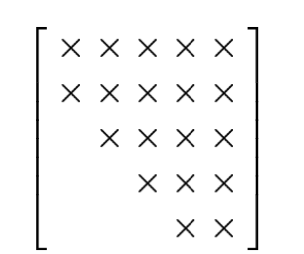A Course on Numerical Linear Algebra¶
Instructor: Deniz Bilman
Textbook: Numerical Linear Algebra, by Trefethen and Bau.
Lecture 26: Reduction to Hessenberg or Tridiagonal Form¶
using LinearAlgebra
A = rand(0:20, 6, 6)
6×6 Matrix{Int64}:
14 2 18 16 8 0
1 11 8 9 16 1
4 0 13 8 0 4
16 11 5 19 20 13
5 16 19 14 18 17
15 18 16 6 20 15
# This is what you'd get when the iterative algorithm
# computing the Schur factorization converges
(T,Q) = schur(A);
T
6×6 Matrix{Float64}:
65.9173 6.91374 12.9358 11.9099 -2.30041 16.867
0.0 16.0483 -0.639618 4.87063 8.26544 0.519912
0.0 0.0 -0.216094 12.2684 5.40949 0.550169
0.0 0.0 -7.56057 -0.216094 7.5363 -0.393075
0.0 0.0 0.0 0.0 0.174992 -13.2969
0.0 0.0 0.0 0.0 0.0 8.29157
The Schur form of a matrix always exists and the eigenvalues sit at the diagonal of $T$ and stare at us.
Λ = eigvals(A)
6-element Vector{ComplexF64}:
-0.216094247712258 - 9.630996572139273im
-0.216094247712258 + 9.630996572139273im
0.1749915319448782 + 0.0im
8.291565276575604 + 0.0im
16.048344415238855 + 0.0im
65.91728727166523 + 0.0im
In case the eigenvalues are complex-valued, there is a way to handle the process with real arithmetic, and the resulting matrix $T$ becomes quasi-triangular, with complex eigenvalues being represented as the eigenvalues of $2\times 2$ blocks on its diagonal. This choice can be made for speed purposes.
T[3:4,3:4]|>display
a=(T[3:4,3:4])[1,1];
b=(T[3:4,3:4])[1,2];
c=(T[3:4,3:4])[2,1];
d=(T[3:4,3:4])[2,2];
2×2 Matrix{Float64}:
-0.216094 12.2684
-7.56057 -0.216094
b*c < 0.
true
a + 1im*sqrt(-b*c)
-0.216094247712258 + 9.630996572139274im
eigvals(T[3:4,3:4])
2-element Vector{ComplexF64}:
-0.216094247712258 - 9.630996572139273im
-0.216094247712258 + 9.630996572139273im
OK. But we first transform to an upper-Heisenberg matrix (all entries below the first subdiagonal are zero.). That is the first phase:
$$ A\mapsto H $$
F = hessenberg(A);
H = F.H
6×6 UpperHessenberg{Float64, Matrix{Float64}}:
14.0 -16.179 -8.56849 -13.9849 9.78923 -4.62762
-22.8692 42.3939 32.2153 -2.97531 -12.8806 -3.95445
⋅ 23.3027 17.3303 2.51689 -11.8056 -0.682365
⋅ ⋅ -14.1685 4.40003 1.00031 0.82663
⋅ ⋅ ⋅ -6.97764 3.60084 -2.71927
⋅ ⋅ ⋅ ⋅ 11.8614 8.27492
# The unitary transformation that gets us to H
Matrix(F.Q)
6×6 Matrix{Float64}:
1.0 0.0 0.0 0.0 0.0 0.0
0.0 -0.0437269 -0.449615 0.65065 0.508113 -0.338246
0.0 -0.174908 -0.13215 -0.55967 0.756414 0.257975
0.0 -0.699631 0.0906378 -0.245188 -0.103325 -0.656893
0.0 -0.218635 -0.842596 -0.161143 -0.398657 0.239452
0.0 -0.655904 0.249399 0.421117 0.00751394 0.574625
How does this work?
One may think of unitary triangularization via Householder reflectors. But that is not a good idea. See why for yourself: remember, we will produce $Q_1^* A Q_1$. Does that result in the desired sparsity?
What is a better idea?
Do not use a unitary matrix that acts on all the rows of $A$. Instead select a Householder reflector $Q_1^*$ that leaves the first row unchanged.
Then $Q_1^* A$ will form linear combinations of rows $2,\ldots,m$ and introduce zeros in the first column in rows $3,\ldots,m$.
Now take $Q_1$ and multiply $(Q_1^* A)$ on the right to obtain $Q_1^* A Q_1$. This will leave the first column of $Q_1^* A$ unchanged! So we will not ruin our work (on introducing zeros).
This idea is repeated to introduce zeros into subsequent columns. For example, the second Householder reflector, $Q_2$, leaves the first and second rows and columns unchanged.
After repeating this process $m-2$ times, we have a product in Hessenberg form as desided.
$$ \underbrace{Q_{m-2}^* \cdots Q_2^* Q_1^*}_{Q^*} A \underbrace{Q_1 Q_2 \cdots Q_{m-2}}_Q=H . $$

Algorithm 26.1 Householder Reduction to Hessenberg Form¶
- for $k=1$ to $m-2$
- $x=A_{k+1: m, k}$
- $v_k=\operatorname{sign}\left(x_1\right)\|x\|_2 e_1+x$
- $v_k=v_k /\left\|v_k\right\|_2$
- $A_{k+1: m, k: m}=A_{k+1: m, k: m}-2 v_k\left(v_k^* A_{k+1: m, k: m}\right)$
- $A_{1: m, k+1: m}=A_{1: m, k+1: m}-2\left(A_{1: m, k+1: m} v_k\right) v_k^*$
Operation Count¶
$$ \text { Work for Hessenberg reduction: } \quad \sim \frac{10}{3} m^3 \text { flops. } $$
Note that $A= Q H Q$ is almost a Schur factorization! One just needs to transform the subdiagonal to $0$. Recall the example output:
H
6×6 UpperHessenberg{Float64, Matrix{Float64}}:
14.0 -16.179 -8.56849 -13.9849 9.78923 -4.62762
-22.8692 42.3939 32.2153 -2.97531 -12.8806 -3.95445
⋅ 23.3027 17.3303 2.51689 -11.8056 -0.682365
⋅ ⋅ -14.1685 4.40003 1.00031 0.82663
⋅ ⋅ ⋅ -6.97764 3.60084 -2.71927
⋅ ⋅ ⋅ ⋅ 11.8614 8.27492
The Hermitian Case: Reduction to Tridiagonal From¶
If $A$ is hermitian, the algorithm just described will reduce $A$ to tridiagonal form (at least, in the absence of rounding errors). This is easy to see: since $A$ is hermitian, $Q^* A Q$ is also hermitian, and any hermitian Hessenberg matrix is tridiagonal.
$$ \text { Work for tridiagonal reduction: } \quad \sim \frac{4}{3} m^3 \text { flops. } $$
# Symmetrize A and obtain B
B = A+A'
6×6 Matrix{Int64}:
28 3 22 32 13 15
3 22 8 20 32 19
22 8 26 13 19 20
32 20 13 38 34 19
13 32 19 34 36 37
15 19 20 19 37 30
# H for B is also Hermitian, therefore tridiagonal (banded matrix).
hessenberg(B)
Hessenberg{Float64, UpperHessenberg{Float64, Matrix{Float64}}, Matrix{Float64}, Vector{Float64}, Bool}
Q factor: 6×6 LinearAlgebra.HessenbergQ{Float64, Matrix{Float64}, Vector{Float64}, false}
H factor:
6×6 UpperHessenberg{Float64, Matrix{Float64}}:
28.0 -43.715 4.18911e-15 -1.92664e-15 5.40675e-16 -4.4296e-15
-43.715 92.6007 -50.2489 -1.7034e-14 -6.1369e-15 -2.55385e-15
⋅ -50.2489 43.1229 -6.92658 5.22226e-16 3.66116e-15
⋅ ⋅ -6.92658 -5.80194 6.96338 4.35548e-15
⋅ ⋅ ⋅ 6.96338 13.778 8.95241
⋅ ⋅ ⋅ ⋅ 8.95241 8.30033
Stability¶
Theorem:¶
Let the Hessenberg reduction $A=Q H Q^*$ of a matrix $A \in$ $\mathbb{C}^{m \times m}$ be computed by Algorithm 26.1 on a computer satisfying the axioms A and B (from Lecture 13), and let $\tilde{Q}$ and $\tilde{H}$ the computed factors (again taking $\tilde{Q}$ to be exactly unitary - see Lecture 16). Then we have
$$ \tilde{Q} \tilde{H} \tilde{Q}^*=A+\delta A, \quad \frac{\|\delta A\|}{\|A\|}=O\left(\epsilon_{\text {M}}\right) $$
for some $\delta A \in \mathbb{C}^{m \times m}$.